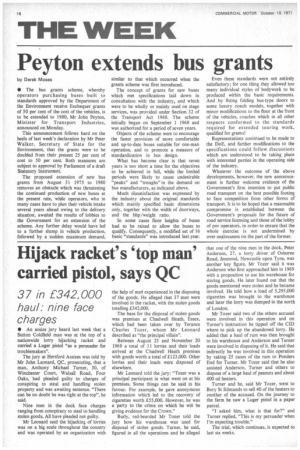Peyton extends bus grants
Page 18

If you've noticed an error in this article please click here to report it so we can fix it.
by Derek Moses • The bus grants scheme, whereby operators purchasing buses built to standards approved by the Department of the Environment receive Exchequer grants of 50 per cent of the cost of the vehicles, is to be extended to 1980, Mr John Peyton, Minister for Transport Industries, announced on Monday.
This announcement follows hard on the heels of last week's declaration by Mr Peter Walker, Secretary of State for the Environment, that the grants were to be doubled from their present 25 per cent of cost to 50 per cent. Both measures are subject to approval by Parliament of a draft Statutory instrument.
The proposed extension of new bus grants from August 31 1975 to 1980 removes an obstacle which was threatening the continued production of new buses at the present rate, while operators, who in many cases have to plan their vehicle intake several years ahead owing to the delivery situation, awaited the results of lobbies to the Government for an extension of the scheme. Any further delay would have led to a further slump in vehicle production, followed by a sudden maximum demand, similar to that which occurred when the grants scheme was first introduced.
The concept of grants for new buses which met specifications laid down in. consultation with the industry, and which were to be wholly or mainly used on stage services, was provided under Section 32 of the Transport Act 1968. The scheme initially began on September 1 1968 and was authorized for a period of seven years.
Objects of the scheme were to encourage the faster provision of more comfortable and up-to-date buses suitable for one-man operation, and to promote a measure of standardization in bus design.
What has become clear is that seven years is too short a time for the objectives to be achieved in full, while the limited periods were likely to cause undesirable "peaks" and "troughs" in the demand on bus manufacturers, as indicated above.
Much dissatisfaction was expressed by the industry about the original standards which mainly specified basic dimensions only, together with the width of doorways, and the bhp/weight ratio.
In some cases floor heights of buses had to be raised to allow the buses to qualify. Consequently, a modified set of 16 basic "standards" was introduced last.year. Even these standards were not entirely satisfactory; for one thing they allowed too many individual styles of bodywork to be produced within the basic requirements. And by fitting folding bus-type doors to some luxury coach models, together with minor modifications to the floor at the front of the vehicles, coaches which in all other respects conformed to the standards required for extended touring work, qualified for grants!
Representations continued to be made to the DoE, and further modifications to the specifications could follow discussions which are understood to be taking place with interested parties in the operating side of the industry.
Whatever the outcome of the above developments, however, the new announcement is further welcome evidence of the Government's firm intention to put public road transport on the best possible footing to face competition from other forms of transport. It is to be hoped that a reasonable compromise is established between the Government's proposals for the future of road service licensing and those of the lobby of psv operators, in order to ensure that the whole exercise is not undermined by over-zealousness on the part of the former.
















































































































